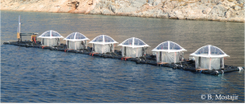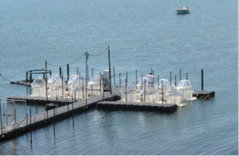Facilities
Transnational Access
Metadata & Data
Papers & Reports
Knowledge Base
MEDIMEER (MEDIterranean platform for Marine Ecosystem Experimental Research)
CNRS
Infrastructure Description
MEDIMEER is a unique platform on the French Mediterranean coast designed to run in-situ mesocosm experiments in coastal waters (Fig.9.14). The facility, with up to 12 pelagic mesocosms (1.2 m diameter, 2 m depth, ~2 m3 volume each), is moored in the Lagoon of Thau, 20 km southwest of Montpellier, hosted by the Marine Station of Sète, which belongs to the University of Montpellier (Dep.1). The mesocosms are attached to pontoons, maintained by a floating structure made of stainless steel and moored in the lagoon to provide natural water- temperature and light conditions. Six mesocosms can be fitted with a sensor array, enabling the acquisition of high- frequency data during experiments. Moreover, instruments for continuous measurements of air temperature and solar irradiance are installed on the same pontoon.
Several laboratories immediately adjacent to the mesocosm infrastructure are dedicated to participating in MEDIMEER experiments. They provide access to 2 wet laboratories (total area of 35 m2), 2 microbiological laboratories (total area of 40 m2), chemical laboratory (15 m2), microscopy laboratory (20 m2), 4 multitask laboratories (total of 65 m2 for sample processing), workshop (50 m2) and office space (60 m2) in the nearby buildings of the Marine Station of Sète. Available equipment and instruments include spectrofluorometer, spectrophotometer with an integrating sphere, oxygen titrator, nutrient autoanalyser, flow cytometer (FacsCalibur, Becton Dickinson), PAM fluorometer (Aquapen, PSI), epifluorescence microscope, dissecting microscopes, and various benchtop instruments (pumps, liquid nitrogen container, balances, incubators, ovens, cooled centrifuges, hoods, and more).

Facility Description
Pelagic, marine, outdoor, in-situ
1. Permanent floating structure: up to 12 pelagic mesocosms (1.2 m diameter, 2 m depth, ~2 m3 volume each). Fig. 1 & 2
2. Permanent floating structure: 3. Indoor structure:
3. Mobile: LAMP is composed of 9 individual structures that can be deployed individually or bonded according to experimental design. Fig. 3
Organisation Address
MEDIMEER
2 Rue des Chantiers
Sète
34200
France
Infrastructure Address
Sète
France
Information Sources
Location
Gallery
Contacts
Behzad Mostajir
Controlled Parameters
CO2, pH, nutrients, plankton composition, temperature, light, salinity, turbulence, conductivity, chlorophyll a fluorescence and dissolved oxygen concentration. Some of The data are stored and transmit in real time
Research Topics
Plankton food web structure and functioning and their responses to global and local stressors.
Experiment Years
Since 2003
TA Support
Services currently offered by the infrastructure: Users will get full access to the mesocosms, laboratories and equipment available in the laboratories participating in MEDIMER. The large water volume in the mesocosms permits intense and repeated sampling for several weeks and multiple users. High-frequency data from automatic sensor measurements made before and during experiments can be provided by collaborating with local teams. To date, a number of mesocosm experiments realized through nationally funded projects and Transnational Access provision during the MESOAQUA FP7 project, have already benefitted from MEDIMEER. Topics have ranged from bacteria to zooplankton responses to various aspects global environmental changes
Support offered under AQUACOSM: All users will be offered technical, logistic and scientific support before and during the experiments. This includes:
-
Access to the MEDIMER mesocosms and associated materials for experimentation
-
Access to temperature and solar irradiance data recorded by the weather station at the site
-
Access to a range of laboratories in the Marine Station of Sète (see above)
-
Standard lab equipment such as fridges, freezers, liquid N, bench-top hoods, autoclaves, distilled water and ultra-pure water
-
Technical and logistic support and supervision for using the experimental facility
-
Training on specific instruments by MEDIMEER technical staff and collaboration with local staff during sample and data analysis.
-
There are also a boat, aquaculture tanks, cold room, and possibility for animal collection by a diver
Support offered under AQUACOSM-plus: Users are offered access to the facility described above, including technical, logistic and scientific support. In addition, they will have access to meteorological and solar irradiance data recorded, receive training by MEDIMEER technical staff and collaboration with the local scientific team during sampling and data analysis. Boats and divers can also be provided.
TA Modality of Access
Modality of access under AQUACOSM-plus: A total of 500 persons days can be allocated to external users involved in one or two mesocosm experiments during M10-45 of AQUACOSM-plus Transnational Access provision. We offer access to ca 14 persons for ca 36 days each. The access cost offered by MEDIMEER is based on Actual Cost calculation, which includes needed preparatory work (before and at site), as well as specific training needed at the sites to complete the specific projects.
TA Accommodation
Dormitories at the Marine Station of Sète or possibility to rent the hotel rooms or a villa.


